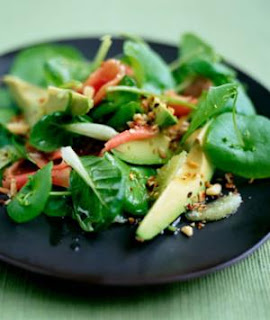The plank (or hover) is an isolation move used in Pilates and Yoga
and works the abs, back, arms and legs. The plank also targets your internal
abdominal muscles.
How to Do It: Lie face down on mat with elbows resting on floor next
to chest. Push your body off the floor in a pushup position with body
resting on elbows or hands. Contract the abs and keep the body in a
straight line from head to toes. Hold for 30-60 seconds and repeat as
many times as you can. For beginners, do this move on your knees and
gradually work your way up
to balancing on your toes.
woensdag 25 juli 2012
8 Healthy Fats to Add to Your Salad
8 Healthy Fats to Add to Your Salad
Get maximum nutrition and stay full longer with these salad add-ons.
But that doesn't mean you should pull out the Ranch and blue cheese dressing just yet. Researchers discovered that certain types of fats were more efficient at drawing out the nutrients, meaning that a salad didn't have to become a high-fat affair.
Related: 15 Bad Excuses Women Make for Not Eating Healthy
"You can absorb significant amounts of carotenoids with saturated or polyunsaturated fats at low levels, but you would see more carotenoid absorption as you increase the amounts of those fats on a salad," said lead researcher Mario Ferruzzi, an associate professor of food science at Purdue, in a statement. The secret? Using monounsaturated fats, which aided nutrient absorption, even in a small portion size of three grams.
What is Fitness
What is fitness and what does it mean to be physically "fit?" Physical
fitness is defined as "a set of attributes that people have or achieve
that relates to the ability to perform physical activity"
In other words, it is more than being able to run a long distance or lift a lot of weight at the gym. Being fit is not defined only by what kind of activity you do, how long you do it, or at what level of intensity.
While these are important measures of fitness, they only address single areas. Overall fitness is made up of five main components:
In other words, it is more than being able to run a long distance or lift a lot of weight at the gym. Being fit is not defined only by what kind of activity you do, how long you do it, or at what level of intensity.
While these are important measures of fitness, they only address single areas. Overall fitness is made up of five main components:
- Cardiorespiratory endurance
- Muscular strength
- Muscular endurance
- Body composition
- Flexibilit
- What is "cardiorespiratory endurance (cardiorespiratory fitness)?"
Cardiorespiratory endurance is the ability of the body's circulatory and respiratory systems to supply fuel during sustained physical activity To improve your cardiorespiratory endurance, try activities that keep your heart rate elevated at a safe level for a sustained length of time such as walking, swimming, or bicycling. The activity you choose does not have to be strenuous to improve your cardiorespiratory endurance. Start slowly with an activity you enjoy, and gradually work up to a more intense pace.
What is "muscular strength?"
Muscular strength is the ability of the muscle to exert force during an activity. The key to making your muscles stronger is working them against resistance, whether that be from weights or gravity. If you want to gain muscle strength, try exercises such as lifting weights or rapidly taking the stairs. What is "muscular endurance?" Muscular endurance is the ability of the muscle to continue to perform without fatigue To improve your muscle endurance, try cardiorespiratory activities such as walking, jogging, bicycling, or dancing.
What is "muscular endurance?"
Muscular endurance is the ability of the muscle to continue to perform without fatigue To improve your muscle endurance, try cardiorespiratory activities such as walking, jogging, bicycling, or dancing.
What is "body composition?"
Body composition refers to the relative amount of muscle, fat, bone, and other vital parts of the body A person's total body weight (what you see on the bathroom scale) may not change over time. But the bathroom scale does not assess how much of that body weight is fat and how much is lean mass (muscle, bone, tendons, and ligaments). Body composition is important to consider for health and managing your weight!
What is "flexibility?"
Flexibility is the range of motion around a joint Good flexibility in the joints can help prevent injuries through all stages of life. If you want to improve your flexibility, try activities that lengthen the muscles such as swimming or a basic stretching program.
World-Class Fitness in 100 Words:
■ Eat meat and vegetables, nuts and seeds,
some fruit, little starch and no sugar. Keep
intake to levels that will support exercise but
not body fat.
■ Practice and train major lifts: Deadlift, clean,
squat, presses, C&J, and snatch. Similarly,
master the basics of gymnastics: pull-ups,
dips, rope climb, push-ups, sit-ups, presses to
handstand, pirouettes, flips, splits, and holds.
Bike, run, swim, row, etc, hard and fast.
■ Five or six days per week mix these elements
in as many combinations and patterns
as creativity will allow. Routine is the enemy.
Keep workouts short and intense.
■ Regularly learn and play new sports.
Abonneren op:
Posts (Atom)



